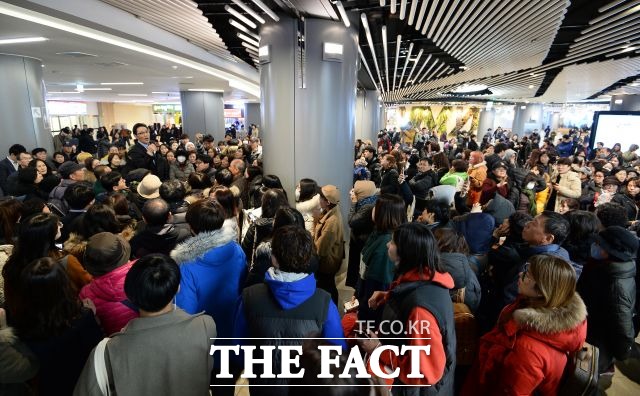
유행은 항상 오고 간다. 한국에서는 유독 그 속도가 장난이 아니다. 특히 한국의 패션 유행은 연예인들이나 SNS 스타들이 무엇을 입고 있느냐에 따라서 항상 요동친다. 한국 젊은이들은 유난히 유행에 민감하다. 왜냐하면 자기들 ‘롤 모델’이 멋지다고 말해주거나 그와 유대감을 같게 해주는 것이라면 무조건 따라가야 하기 때문이다. 몇 가지 요인들이 유행을 증폭시킨다. ‘쿨’한 것을 추종하는 경향, 대량 소비와 소비지상주의 확산, 원하는 것을 꼭 갖고야 말겠다는 욕심 등이다. 그러나 사회의 가치와 우선순위에 대한 많은 문제가 소비 욕망 속에 들어 있음을 유행은 거울처럼 우리에게 보여준다.
새로운 유행에 대한 한국 미디어의 최근 기사들은 한 패션 아이템 돌풍이 강하게 불어서 한국인들이 몰려들고 있다고 소개하고 있다. 영어로는 애벌레 자켓(caterpillar jacket)이라고 하는 롱패딩이 한국 전역을 휩쓰는 최신 유행 아이템이라는 것. 중앙일보 영문판 기사 하나는 수백 명 구매자들이 서울 롯데 백화점 앞에서 밤샘했다가 그 다음날 아침 평창 올림픽 공식 롱패딩을 샀다는 얘기를 상세히 전했다(https://goo.gl/hLGHaA). 원래 평창 올림픽 공식 롱패딩은 거위털로 만들어졌으며, 그리 비싸지 않은 가격이어서 순식간에 젊은이들 사이에 유행하게 됐다고 한다. 그러나 롱패딩이 한정판이었고 순식간에 온라인에서 매진되자, 한정품이 영구히 사라지게 전에 오프라인 매장에서 기필코 사야겠다는 구매욕을 부채질했다고 한다.

평창 롱패딩에 대한 초기의 광란이 비슷한 롱패딩의 다른 브랜드 구매 열기로 이어지고 있다. 여러 개의 브랜드들이 현재 다양한 컬러와 디자인으로 시중에 나와 있으며, 이들은 수십 만 원에서 100만 원을 호가하기도 한다. 당장 올 겨울에 롱패딩은 한국에서 필수품이 되고 말았다. 한국 전역에서, 심지어 기후가 온화한 부산에서도 검거나 하얀 롱패딩을 입고 있는 젊은이들을 찾는 일은 그리 어려운 일이 아니다. 패션이란 그 사람이 누구냐는 것을 표현해주며, 롱패딩의 유행 역시 한국인의 정체성을 말해준다. 순식간에 벌어진 롱패딩 마니아의 출현은 한국 문화의 집단성을 뚜렷이 보여준다. 그 집단성은 곧 옷 하나에 대한 유행이 거의 하룻밤 사이에 일어났다는 사실에서 잘 드러난다.
유행은 원래 제한된 기간에 확 퍼지는 성질을 가지고 있다. 시장에서 포화 상태가 될 때까지 유행 품목의 구매 행렬이 이어지다가, 결국에는 끝물이 보이면서 구매욕도 사라진다. 그러면 새로운 그 무엇이 다시 유명해지고, 새 유행이 탄생한다. 예를 들면, 수년 전 노스페이스 자켓이 한국의 청소년들 사이에서 거짓말처럼 대유행했다. 뉴스페이스 자켓 물결이 전국의 중고등학교는 물론 대학가 캠퍼스에서도 흘러 넘쳤다. 롱패딩이 지금 과거의 노스페이스 자켓이 사라진 자리를 대체하고 있으며 급속도로 소비자들을 끌어당기고 있다. 아마도 내년에는 다른 패션 아이템이 롱패딩을 밀어낼 것이며, 그런 식으로 유행은 순환을 계속할 것이다. 한 서양 속담이 이 상황을 정확하게 묘사하고 있다. “송구영신(送舊迎新), 낡은 것을 버리고 새 것을 받아들인다(Out with old and in with the new).”
유행이 반복되면, 사회와 문화에는 어떤 영향을 미칠까? 가장 뚜렷한 영향은 가족에게 재정적 부담을 준다는 것이다. 한국에는 이미 이런 부담에 대한 신조어가 생겨났다. 그게 바로 등골 브레이커(영어에도 같은 의미로 ‘spine breakers’라는 단어가 있음)다. 이 말은 자식들이 최신 유행을 쫓아가는 데 드는 경제적 부담을 온통 부모들이 지게 돼서 부모의 등골이 휘게 됨을 비유한 말이다. 한국 자녀들이 최신 유행 아이템을 가지려고 애를 쓸수록, 부모들은 자녀들이 최신 유행에 뒤떨어져서 또래 친구들에게 기죽는 일이 생기지 않게, 결국은 지갑을 경쟁적으로 열게 된다. 이런 유행 풍조는 아이들의 학교생활에 가해지는 일종의 사회적 압력이며, 그 유행 아이템을 사야만 어린 학생들은 친구들과 어울릴 수 있다는 안도감을 갖게 된다.
유행의 다른 영향은 개성보다는 획일성을 조장한다는 것이다. 개성을 찾으라는 말은 남과 다르고 차별화되어야 한다는 의미로 그래야 문화의 다양성을 창조할 수 있다는 뜻이다. 개성은 또한 새로운 것, 남과 구별되는 독창적인 것과도 연결된다. 언뜻 들으면, 이 말은 하얀 무리 속에서 눈에 띄는 검은 양이 되라는 의미로 다가온다. 이 말의 참 뜻은 유행의 거부다. 유행은 원래 새롭고 특별해지자는 의도에서 출발하지만, 유행의 종말은 유행에의 동참이다. 근본적으로 모든 사람이 유행을 다 따라하면, 모든 사람이 같아 보인다. 그래서 유행의 결과는 획일성이다. 최근 코리아 헤럴드 기사는 요즘 중고등학교 학생들이 모두 롱패딩을 입고 다니기 때문이 이를 ‘교복’이라고 부른다고 보도했다(https://goo.gl/9ax3uV).
유행은 고도의 물질주의 문화를 조장하는 데 기여한다. 일반인들의 통상적인 구매 습관은 각자의 물건에 대한 개인적 가치에 따른다. 그러나 유명 연예인들이 인스타그램 등 SNS에서 아름다움과 인기를 보장한다고 소개하는 아이템들은 대개는 스폰서가 뒤에 있는 것들이며 결과적으로 사람들의 물질주의와 천박성을 부채질할 뿐이다. SNS의 즉시성은 유행이 급속도로 퍼지는 데 일조하며, 소비자들이 SNS를 보고 어떤 한 유행을 쫓아오면, SNS는 재빨리 또 다른 새 유행을 소개한다. 계절적 유행은 한편 단기적으로는 경제를 활성화하지만, 결국 유행을 쫓아가는 소비는 낭비일 뿐이다. 소비가 늘어나야 신상품이 들어설 자리가 생기게 재고품이 처리된다. 소비자들은 자신이 필요해서가 아니라 유행에 따라가기 위해 신상품을 사도록 강요받고 있으며, 결과적으로 유행은 주기가 짧아질 수밖에 없다.
북한의 핵 위협이 날로 심각해지고, 경기는 회복 기미가 안 보이며, 가계 대출이 기록적으로 높은 이때에, 전국적 현상이 되도록 롱패딩이 어쩌면 이렇게 잘 팔리는 수 있을까? 급작스런 롱페딩 유행은 불행히도 아무도 예측하지 못했고 설명하기도 힘들다. 평창 동계 올림픽이 한국인에게는 오래 기다려온 최대 이벤트이지만, 평창 롱팽딩이 광적으로 팔리는 것에 비해 올림픽 관람 티켓 판매가 저조한 것은 매우 놀라운 일이다. 네이버 검색어에 수주 동안 ‘평창 롱패딩’이 올라 간 것은 한국 사람들은 올림픽이란 실제 이벤트보다 올림픽 패션에 더 관심이 많다는 사실을 보여준다. 한국인들의 이번 겨울 지상 목표는 “가장 최신 유행 옷을 입은 것을 남에게 보여주는 것이 가장 중요한 일”이란 것이다.
[편집자 주] 위 칼럼은 다음 영어 원문을 번역한 것입니다.
The ‘Caterpillar’ Jacket Craze in Korea
Trends come and go, and in Korea, they do so at a very fast pace. Fashion trends in particular have been dynamic, constantly changing according to what celebrities and social media influencers are wearing. Young people are especially vulnerable to the power of trends, as they look to role models to tell them what is cool and to give them a sense of belonging. Several elements give trends so much gravity: the constant pursuit of being ‘cool’, the pervasiveness of consumerism and mass consumption, and the promise that everything can be obtained. However, these trends that mirror the desires of consumers raise a number of questions about the priorities and values of society.
Recent stories in the media about a new trend have created a fashion craze and have left consumers scrambling to keep up. Long padded winter jackets, also known as ‘caterpillar jackets’, are the newest trend sweeping across the country. One Korean Joongang Daily newspaper story describes how hundreds of customers spent the night inside a Lotte department store in Seoul so that they could buy special Pyeongchang Winter Olympic caterpillar jackets in the morning (https://goo.gl/hLGHaA). The Pyeongchang jackets were made of goose down and available for a reasonable price, quickly becoming popular among young people. However, the jackets were limited in production and quickly sold out online, fueling the demand for in-store purchases until they sold out permanently.
The initial frenzy for the Pyeongchang jackets has transferred onto other brands that make similar jackets. Various competing brands now offer caterpillar jackets in a range of colors and styles, costing anywhere from several hundred thousand to over a million won. Caterpillar jackets have become a must-have item for the winter season in Korea. It is easy to spot young people wearing these long white or black jackets, even in temperate Busan. Fashion is an expression of who we are and so the caterpillar jackets say much about our identity. The sudden mania surrounding the jackets highlights the collectivism of Korean culture and how this makes creates trends seemingly overnight.
Trends by their very nature are designed to be popular for a limited time – they are highly sought after until they reach a saturation point in the market and eventually lose their edge and desirability. Soon, something else becomes popular and a new trend is born. Several years ago, for example, North Face winter jackets were incredibly popular among youth in Korea. The North Face jackets became a common sighting on high school and university campuses throughout the country. Caterpillar jackets have now become the new trend, replacing the North Face fad and driving consumer demand at a rapid pace. Next year, predictably, another trend will be popular and the cycle will continue. One idiom describes this perfectly: "Out with old and in with the new."
So what effect do these trends have on society and culture? The first and most prominent effect is the financial burden it creates for families. A new phrase was even created to describe this burden, in calling trendy products 등골 브레이커 or “spine breakers”. This refers to the economic toll placed on parents who pay for their children to have the latest trends and how it figuratively breaks their backs. As Korean youth strive to obtain the newest products, parents ultimately end up competing with their wallets in an effort to keep their kids trendy and accepted by their peers. Fashion trends add to the social pressures of school life and so buying these products fulfills the need that many students have of fitting in among their classmates.
Another effect of following trends is the creation of uniformity rather than individuality. To be an individual means to be different and to stand out, which creates diversity in culture. Individuality is also related to the idea of being ‘cool’, to be unique compared to everyone else. For many, this is the idea of being a black sheep in a white flock. However, there is an inherent contradiction in trends. While the intention is to be cool and special, the reality is that it leads to conformity. Basically, if everyone follows the fashion trend, then everyone will look the same. We can see this uniformity demonstrated in language, as one Korea Herald news story explains how netizens refer to the caterpillar jackets as “uniforms” for high school students because it makes them look so similar (https://goo.gl/9ax3uV).
Trends also contribute to a culture of hyper-materialism. The habit of buying and consuming products on a regular basis can lead to personal value being based upon the trendy products that are owned. Celebrities on social media also fuel this materialism and superficiality, as their Instagram photos reveal new styles and endorse trendy products which promise beauty and popularity. The immediacy of social media thrusts trends forward at such a high speed, that just as consumers begin following one trend, their attention is diverted to a new one. While these seasonal trends may give a short-term boost to the economy, they end up being incredibly costly and wasteful. Consumption increases as last year’s 'old' products are discarded to make way for new products. This creates a short attention span for consumers who are bombarded with trendy products and buy them not for necessity but in an attempt to stay cool and relevant.
In a time of North Korean nuclear threats, a sluggish economy, and record high household debt, how can buying a caterpillar jacket have become such a phenomenon? Unfortunately, these trends can rarely be explained or predicted. When considering that the winter Olympics will be one of the biggest events to ever come to Korea, it is surprising that sales of tickets to the games have been slow compared to the craze surrounding the Pyeongchang jackets. The fact that there is more excitement about a Olympic fashion item than the actual events is also evident when looking online, as ‘Pyeongchang Long Padding’ became the most popular search term on Naver in recent weeks. The priority of many people this winter season seems to be clear: that being seen wearing the newest trend is most important of all.


